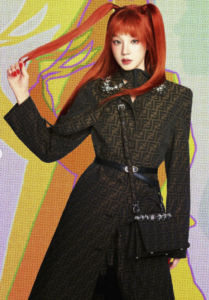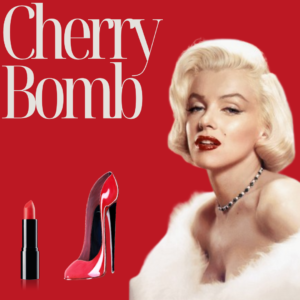GRAPHIC DESIGN Sarah Pasquini
The countdown hits 00:00:00 and the YouTube lights fade, the white background of my ‘theatre’ mode video moves to grey. Lights from somewhere off screen illuminate a runway, the score begins to flood the speakers of my MacBook and models emerge from invisible slits in the wall. As the clothes bounce and sway down the aisle, comments come flooding in from the right side of my virtual seat (“YASSSS”, “We love to see it!”, and “Can’t believe Gap really did that to Telfar”), to let me know what some of the world thinks about *insert brand name here’s* latest collection. Or perhaps, multicoloured hearts float onto the runway from the bottom right hand corner of your phone.
Pre-Covid, fashion shows had started to transform. Certainly their presence did not exist solely online, but designers such as Anthony Vaccarello at Saint Laurent, Marine Serre, and Virgil ’50 Bones’ Abloh at Louis Vuitton Mens had all started to incorporate live-streaming into their shows. The new medium of disseminating collections certainly allows for those with sufficient wifi more access than ever before. However, live-streams were simply added virtual seats for those of us whose invites got lost in the mail, not transformations of an old form. As of late there seems to be two dominant conversations surrounding fashion shows as we know them: the hyper-saturation of the seasonal calendar and the actual medium of the show.
Not only has the pandemic produced a global society that is consuming less, it seems to have sparked some designers to move towards producing less.
Issues with the current schedule of fashion is not a new discussion; however, given the pause COVID has forcefully granted all of us, the conversation surrounding the calendar can be explored in depth with more time on most folks’ hands. Early in the pandemic, Alessandro Michele announced Gucci would be moving to a schedule that suits the designer and his team, and Saint Laurent pulled from Paris Fashion Week for the remainder of the year; both moves from the big houses seemed to be motivated by the rapid fire reality of fashion weeks. Designers with less financial backing, and perhaps more intensely affected by the pandemic, decided to hold off on a collection; Bianca Saunders, for example produced a zine in place of her A/W20 collection at London Fashion Week’s first entirely digital and genderless fashion week. Toronto talents like Nikki Wirthensohn Yassemi of NARCES, who saw another TFW cancelled, moved into the mask making game. Not only has the pandemic produced a global society that is consuming less, it seems to have sparked some designers to move towards producing less.
Marc Jacobs, in conversation with Tim Blanks, Editor-at-Large at Business of Fashion (BOF), for Tim Talks began to discuss what fashion would miss if fashion shows permanently lost their physical aspect. Jacobs was concerned with the loss of physicality and sensuality when it comes to garments; the legendary designer spoke to the loss of emotional connectivity with a show and the garments when they exist solely in a digital space. While Jacobs is speaking to the overall spectacle of a show, he’s speaking from a place of immense privilege. For many, fashion weeks do exist only in digital spaces, whether it be Vogue Runway, YouTube, or stan blogs with runway photography, not many folks have the opportunity to witness a show in person. The pandemic has asked designers new ways to communicate their work, if they choose to create at all.
Furthering the accessibility in fashion should exist post-pandemic; these alternative shows should act as a testing ground to continue a conversation about fashion and access beyond a global pandemic.
Hanifa Official’s bridal collection displayed a masterful use of 3-D design, showcasing the hypnotic movement of an array of body-hugging dresses with ruching and flowing trains. Designer Nico Verhaegen followed suit with a 3-D collection as well mentioning in an Instagram post on April 15th that “COVID-19 made adapting necessary, for this collection I will work solely with 3-D scans and the heads of models I still have on my computer. The body throughout the collection will be a simulated body since fittings are forbidden…” Granted, both Hanifa Official and Nico Verhaegen showed earlier in the pandemic so their options were limited compared to June or July in some places. The recent fashion weeks, specifically Paris Fashion Week which I find myself writing this piece in the middle of, has shown less stellar adaptations of physical shows. Kiko Kostadinov’s menswear collection was a fitting turned show simply through the fact it was recorded; Yohji Yamamoto stayed true to tradition delivering a video of models strutting the runway reminiscent of fashion weeks of yore. Others like Juun.J, as well as Lucie and Luke Meier at Jil Sander shot an editorial in place of a runway and creative video, while Boramy Viguier managed to create a unique video experience explaining each garment in a plethora of languages as well as ASL. Rushemy Botter and Lisi Herrebrugh of Botter delivered a politically charged video that made Marc Jacobs statements surrounding recorded shows lacking emotional connection fall extremely short.
Some designers have decided to push technology to its limits, where others have chosen not to at all; What becomes clear, however, is the willingness of smaller or newer designers to adapt to the times and create for current consumers. Although the current alternatives to a physical show are temporary, it’s obvious that those who are pushing for access have a closer understanding of the times. Certainly, modified COVID shows are important to maintain health and safety while still selling to a specific percent of folks who are too rich to be phased by a frivolous global pandemic, or, those of us loosely spending their emergency cheques due to the disorienting reality we currently exist in. Furthering the accessibility in fashion should exist post-pandemic; these alternative shows should act as a testing ground to continue a conversation about fashion and access beyond a global pandemic. Those unwilling to transform are stuffing millions into their saddle bags (*cough* Dior *cough*), while buttressing the golden gates at the entrance of the industry.
























